Two cars have vied with the Corvette for the title, America’s sports car. You probably know about the Thunderbird.
You may not know about the AMX.
It came along much later and wasn’t around for long – just three model years, 1968-1970. And of course, AMC itself didn’t last much longer. But while it lasted, the AMX was an interesting attempt at undermining the hegemony of America’s sports car by offering a more affordable alternative to it.
Like the Corvette – and the early T-bird, before it matured into a landau-roofed luxury roller – the AMX was a short-wheelbase two-seater. Unlike the Corvette – but like the early T-bird – the AMX’s body was made of steel.
And it was fast – something the early Corvette wasn’t.
But it came late to the fray.
Corvette had an almost 20 year head start, for openers. And – though AMC’s product planners couldn’t see it coming – Hard Times were just around the corner for the entire car industry by the time the AMX saw daylight. AMC – America’s smallest car company, with a fraction of the market share of GM, Ford or Chrysler – was the least-prepared to weather the coming storm.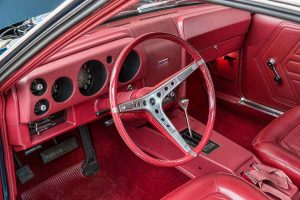
All of which is much too bad, especially given what the AMX might have become.
The American Motors Experimental was conceived as the car which would make AMC hip, as opposed to the purveyor of solid but congenitally unexciting economy cars purchased chiefly by people with both feet solidly in middle age.
America’s other car company had a problem very similar to the problem General Motors’ Pontiac division had just a few years prior – when it was widely viewed as an Old Man’s brand, the car purchased by retirees who couldn’t afford a Buick.
John DeLorean and his crew of young engineers changed that image almost overnight by taking a nothing special two-door Tempest hardtop and – by slipping in a hot-cammed, high-compression 389 V8 snatched from under the hood of a full-sized Bonneville – created the very special GTO.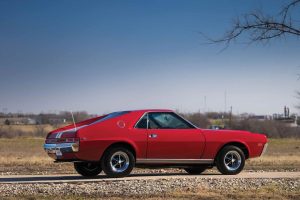
It didn’t just change Pontiac’s fortunes. It changed the industry.
AMC’s had similar hopes for the AMX.
Or rather, AMC’s newly elected chairman of the board, Robert B. Evans, had such hopes.
His name isn’t as well-known as DeLorean’s – in part because John Z was flashier and also because his creations (which included the Grand Prix SSJ) were more commercially successful. But Evans was also a go-getter and he had the same vision. He would transfuse new life – young blood – into AMC. “We have to give the public cars that go beyond what the Big Three gives them,” he said.
He was determined to get what he called “personality cars” into the showrooms. 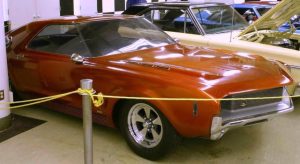
Work began under the auspices of “Project IV” not long after the first GTO hit the streets – and began setting sales records – in 1964.
Non-functional mock-ups were developed at AMC’s Advanced Design Studios and put on display at car shows beginning in 1966; a fully operational prototype was ready the next year.
“We are proceeding cautiously in a hurry,” Evans was quoted as saying in the fall of ’66.
There were actually two different cars under development at the same time – one based on the company’s new Javelin coupe, designed by Richard Teague, using conventional steel panels; the other was a much more radical and composite (fiberglass) bodied car, emulating the Corvette.
AMC’s perennial money problems led to the first option being green-lighted by AMC management. It was much less expensive and R&D intensive to work with the Javelin platform to create what would become the AMX.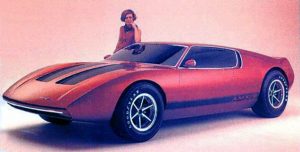
The Javelin’s muscle car wheelbase was shortened by almost a foot, from 109 inches to 97 inches – shorter than the ’68 Corvette’s 98 inch wheelbase – and two of the Javelin’s four seats were scratched off the drawing board. The shortened wheelbase was intended to serve as the basis of a car that could corner as well as go – unlike one-dimensional muscle cars such as the GTO, which were very good at going fast in a straight line but out of its depth you if you didn’t slow for the curves.
The new AMX was a unibodied car, too. Integral body and frame, rather than the body-on-frame construction that was typical of muscle cars like the GTO – so it weighed a lot less than the typical muscle car.
Just 3,362 lbs. vs. 3,840 lbs. for the 1968 GTO.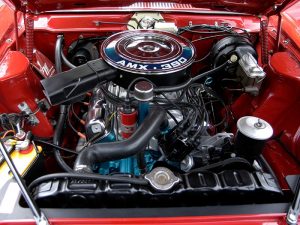
This was also only about 100 lbs. more than the targeted 1968 Corvette – which weighed 3,220 lbs. despite the advantages of its fiberglass body.
What was in line with the GTO and other muscle cars was the AMX’s powerplant. Unlike the early Corvette – which started out with a Blue Flame in-line six – the AMX never had less than a V8 engine under its hood.
There were – once again – some things-in-common with Pontiac’s GTO. The AMC V8 was similar to the Pontiac V8 in that external dimensions of the block/heads didn’t change when displacement did. From the outside, a Pontiac 326 “small block” is almost impossible to distinguish from a 455 “big block” – as opposed to Chevy and Ford small and big block V8s, which use obviously different blocks and heads.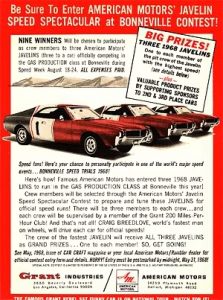
AMX engines ranged from the standard 290 cubic inch (225 hp) V8 to the top-of-the-line 390 (315 hp) but to tell the difference, you had to take them apart – or take them for a drive. The 290 was a mild-performance engine (similar to the two-barrel version of the GTO’s 389 V8) with smaller intake and exhaust valves and a cast steel crankshaft. The 390 got a forged crank, larger intake/exhaust valves and bigger bearings on the bottom end.
There was also a mid-range 343 V8, which got the larger valves – but not the forged crankshaft.
Regardless, you got dual exhaust, traction bars and your pick of a Borg Warner Super T-10 four-speed manual transmission or a specially prepped Shift Command three-speed automatic, which featured a manual-control valve body that allowed the driver to hold each gear as long as he liked. As per the etiquette of the era, you could chirp the tires on the 1-2 and even the 2-3 upshift.
AMC offered a maximum effort Go Package that bundled a locking rear axle with a more aggressive final drive ratio, heavy duty cooling, larger wheels/tires and an upgraded heavy-duty suspension with larger diameter sway bars front and rear.
A 390-powered AMX with the standard 3.15:1 rear axle ratio delivered muscle car acceleration – zero to 60 in about 6.5-6.6 seconds and a mid-high 14 second quarter-mile – while also being capable of hanging on to the bumper of a Corvette in the curves. The ‘Vette still had the advantage – but it wasn’t extreme – and if the AMX pilot knew what he was doing and the Corvette’s pilot did not, the contest’s outcome wasn’t preordained.
Meanwhile the AMX was a bargain – $3,245 for the first-year ’68 model vs. $4,663 for the same year Corvette coupe.
Granted, the Corvette was more sophisticated, with its fiberglass body and four-wheel-independent suspension and better brakes. But these didn’t necessarily make America’s sports car go faster or corner better. The main advantage of an independent suspension is ride quality; a properly set up solid axle/leaf spring car can generate skidpad numbers as impressive as an IRS car – and for a lot less complexity and cost.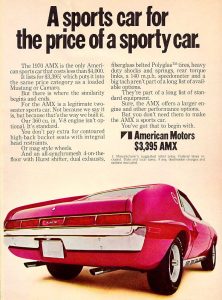
The AMX’s problem wasn’t acceleration or handling. It was niche confusion – and bad timing.
Was it a muscle car for two? Or a budget-priced alternative to the Corvette? Car & Driver’s Brock Yates described the AMX as a “quick car that handled like a sports car, confusing the buying public.” What he meant was that the younger crowd that was the muscle car’s natural demographic didn’t care all that much about cornering; they just wanted to go fast, fry tires and raise Hell.
Preferably with a car full of friends.
But the AMX could only take one friend along for the ride.
Their older bothers – and fathers – bought Corvettes.
The AMX was meant to bridge the gap and split the difference but it never quite caught on as hoped, despite having both muscle car and sports car cred. About 6,725 were sold during the first model year – which was actually only about half a calendar year, as the AMX was a mid-year release. If the ’68 AMX had been announced in late ’67 as a new ’68 model – and had 12 months to accumulate sales rather than about eight – the total for ’68 might have been 10,000 or more.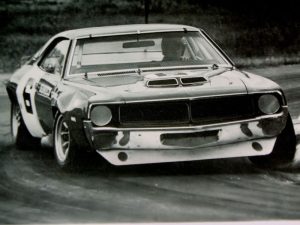
But even that wouldn’t have been enough, probably, for the AMX to establish a real beachhead from which it could dig in and assure itself (and possibly, AMC) a future.
To understand why, have a glance at the sales stats of the ’68 GTO:
87,684 examples.
Put another way, Pontiac sold more GTOs in about three weeks than AMC sold AMXs during the entirety of 1968.
The Corvette was also solidly in the five figures, with 28,566 having been sold in ’68.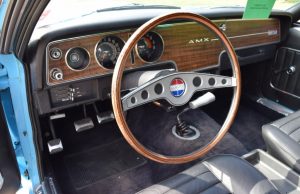
1969 – the AMX’s first full calendar year in production – saw an uptick to 8,293 cars sold; a solid improvement but it still wasn’t enough to generate the warm feelings – and profit margins – necessary to sustain the car. There were tweaks here and there – including an injection-molded one-piece dashpad, a lightweight windshield developed for AMC by Corning glass, a new gauge cluster with 140 MPH speedometer and Hurst shift linkage for four-speed cars.
And if you lived in California, you could order functional sidepipes similar to the Corvette’s.
A pair of modified red, white and blue AMXs campaigned by Craig Breedlove with factory backing set 106 world speed an endurance records, including USAC-sanctioned 189 MPH top speed run at Bonneville Salt Flats.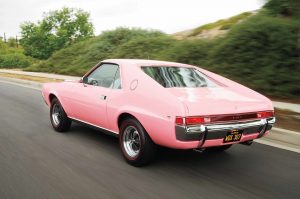
A pink Playmate AMX was awarded by AMC to 1968’s Playmate of the Year, Angela Dorian. The car’s VIN was Dorian’s measurements: 36-24-35.
But while the car was more than solid, the road it traveled was strewn with potholes.
For openers, 1969-1970 was high tide for the muscle car. Within four years, even the GTO would be reduced to a mild performance/appearance package for the Ventura – Pontiac’s version of the downmarket Chevy Nova – instead of being a model (and a high-performance model) in its own right.
The GTO would be gone entirely the next year (1975).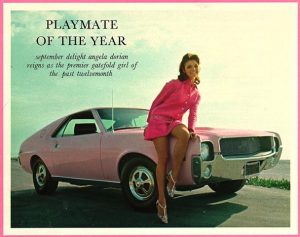
Gas prices had gone up, too. Supplies occasionally evaporated without warning due to belligerent Arabs annoyed by American policies in the Middle East.
But there was an even more belligerent homegrown threat to fun cars – the emerging Safety Cult, led by Ralph Nader and his acolyte Joan Claybrook – who later became the Air Bag Nag at the National Highway Traffic Safety Administration.
The Safety Cult had been festering in the background for several years but was now beginning to metastasize. Nader – better known for his assault on the Corvair he never actually drove – found out that AMC was giving thought to producing an-in-the-wind “Ramble Seat” for the AMX – to expand its passenger-carrying capabilities from just two to four and maybe even five. This idea had been toyed with back during the Project IV days, when the AMX was being developed. 
The thought inside AMC was that this might be the practical inducement needed to goose AMX sales by making the car more like a traditional muscle car without in any way compromising it as a sports car. The essential two-seater (and short wheelbase) layout would be unaffected.
But passenger-carrying ability could be doubled on demand.
Functional prototypes were built and the planned production variant was to be called AMX-R.
But Nader whined – and the decision makers within AMC caved to the pressure before the market ever got a chance to register its vote.
The final-year 1970 cars did however get functional ram-air induction (if you ordered the Go Package, which also got you upgraded front disc brakes) and a new standard 360 V8 (290 hp) which replaced the 290 and 343 V8s. The top-of-the-line 390 remained available optionally and was up-rated to 325 hp. Larger (15×7) “Machine” stamped steel wheels were available, too – along with “Shadow Mask” satin black exterior paint accents.
You could even order leather seats – an unusual high-end feature for a car in the AMX’s price class.
AMC advertising touted it as “A sports car for the price of a sporty car.” That price being $3,395 – significantly less than the base price of the 1970 Corvette ($4,849).
It was well-received by the car press, Motor Trend writers calling it “the best version yet of this blend of muscle car and sports car.”
But in spite of all those improvements, sales tanked to 4,116 cars – a 50 percent drop over the previous year. It wasn’t the AMX’s fault. Sales of the GTO and other muscle cars were slipping, too. Only about half as many 1970 GTOs (40,149) were sold in 1970 as in 1968. Corvette was down in the mouth as well – down to 17,316 cars vs. the 28,566 that Chevy sold back in ’68.
The difference was that GM could afford to take the hit – at least, for awhile – while AMC could not.
America’s fourth car company folded its hand first.
1970 would be the AMX’s final year.
Which is particularly tragic given what might have been. AMC’s vice president of styling, Richard Teague, envisioned a mid-engined AMX. This car – the AMX/3 – was developed by Teague in association with Italian exotic coach builder Bizzarrini.
The front clip looked a lot like Speed Racer’s Mach V – pop-out saw blades optional but pop-up headlights standard. Louvers on the rear deck and hood ducted air to the engine as well as the AC system, enhancing the everyday functionality of systems that were often problematic in the other Italian exotics of the time, which tended to overheat – and under-cool.
It was both eye candy and exotic – with test cars achieving 160 MPH top speeds using the AMC 390 V8 paired up with a four-speed Italian-sourced transaxle. The prototype had a fiberglass body but the proposed production car would have been made of steel. The idea was to build 5,000 of these American exotics annually but in the end, just 5 working cars were produced.
Teague’s vision beautiful but unaffordable.
The AMX name did live on, though. It was used on special versions of other AMC cars, including the Javelin AMX, Hornet AMX, Concord AMX and – finally – the AMC Spirit AMX, which kept the flame flickering into the early 1980s.
But these were mostly appearance packages intended to keep people’s minds off the fact that performance packages had been taken off the table.
AMC itself gave up the ghost in 1988 – 20 years after the AMX’s birth. Just over 19,000 cars were made during the short, three-year production run.
It may never have quite caught on – but it was one helluva ride!
AMX Trivia:
- George Barris – builder of the Batmobile and other ‘60s icons – built a custom ’69 AMX for the TV series, Banacek. This car – the AMX 400 – had a chopped roof and tail-lights that glowed green when the car accelerated – shifting to red when the brakes were applied. Barrie-Designed custom body parts were briefly available through AMC dealers.
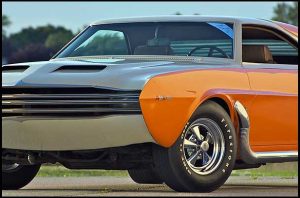
- An AMX competed in the unofficial – and hugely illegal – Cannonball “sea to shining sea” cross-country race organized by Car & Driver’s Brock Yates and other automotive industry/press hooligans. The car was driven by Tom and Ed Bruerton and finished a very respectable fifth place. Their “battle-scarred” ’69 AMX had 90,000 miles on the odometer, according to the brothers – and they made the trip without incident or a speeding ticket, averaging 77.3 MPH.
- To buff the AMX’s street red as a performance car, AMC campaigned a ’69 AMX in NHRA Super Stock drag racing. This specially modified AMX had a 390 with a pair of Holley four barrels, 12.3:1 compression and headers in place of the factory manifolds. AMC claimed 340 hp – just a slight bump over the stock 390’s rating. NHRA factored the actual output at 420 hp – which sounds about right given the car’s best quarter-mile run of 10.73 seconds at 128 MPH.

- Just like GM sometimes worked under the table with friendly, performance-minded dealers (e.g., Royal Bobcat for the GTO, Yenko Chevrolet for the Camaro/Nova) AMC had a few interesting relationships. One of these was with Thoroughbred Motors of Denver, Colorado – which turned factory AMXs into dealer-modded race cars. These were christened Von Piranha AMXs – and they featured functional air scoops on the C-pillars to cool the rear brakes and ducting on the hood to cool the engine – which got a special intake manifold ad high-capacity Holley carburetor. Reportedly, about 22 of these special AMXs were made.
. . .
Excerpted from Eric’s forthcoming (eventually) book, Doomed.
. . .
Got a question about cars – or anything else? Click on the “ask Eric” link and send ’em in!
If you like what you’ve found here, please consider supporting EPautos.
We depend on you to keep the wheels turning!
Our donate button is here.
If you prefer not to use PayPal, our mailing address is:
EPautos
721 Hummingbird Lane SE
Copper Hill, VA 24079
PS: EPautos magnets – they’re back! are free to those who send in $20 or more to support the site. Also, the eBook – free! – is available. Click here. Just enter you email in the box on the top of the main page and we’ll email you a copy instantly!


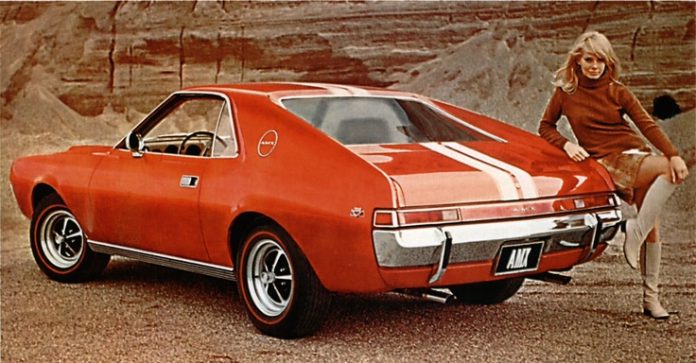

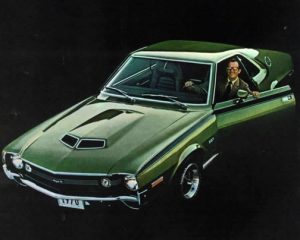








Thanks for this, Eric. Detailed and informative.
Just watched “Misfit Garage” restore a 68 AMX. So much misinformation on that show.
“Looking [X] part for a 68 AMX”. Try Javelin/AMX. It wasn’t “one model year”. The # badge on the dash was not just for “race cars”, but a pretty inaccurate production # series. “390 was rare”[no, it went into Javelins Ambassadors and Rebels/Matadors]. And on and on.
As if there were zero resources for parts, history or connections, though in the end they did credit two or three sources supplying their build.
Still, it was nice to see an AMC anything featured.
Thanks, B!
Hoping to get the book done this year…
Excellent. I looked for “Doomed” on Amazon, saw it mentioned in some older posts.
Is it available ?
Finding so much here than just automotive stuff.
I like your take on things.
Does owning at one time a 1963 Rambler 660 Classic count? Don’t laugh–it was a great car with good power. V-8, three speed manual and overdrive, compact and not bad looking. Such were the days.
At that time in SoCal, the AMX was almost totally out of sight….and out of mind. And I’m speaking as one who then was quite attuned to fast American iron. Our focus was on Cobras, Corvettes, and Shelby Mustangs. On the more affordable end of the spectrum, it was mainly Mopar, with GTOs, 442s, and the miscellaneous Fords on the radar, but in the background.
Of course, by the late 60’s, my attention was drifting to a few other pursuits, too 😉
Still, it’s doubtful that “any” AMC “performance” product, no matter how qualified, could have mustered sufficient cred to warrant any consideration at all.
A friend had an AMX, a strange looking car at the time. He never raced me in the “red bomb”…..and made a point to do so. I never knew if it was a runner or not. The “red bomb” wasn’t a quarter mile car and I made no claims so. A half mile and even the baddest Corvette was sucking exhaust from it.
A one mile race kept my neighbor’s ’66 Chevelle SS 427 with the ultimate mods neck and neck with the 327 ‘red bomb’. They were both “bad” machines. We would have raced AMX’s…if one had been up for it.
A friend had an AMX years ago, 390 V8 with 4-speed trans. It was a hoot to drive!
What’s amazing given how well the AMX handled is that the basic suspension and chassis was shared with the much tamer Rambler American compact, down to the trunnion-based front end in 1968 and 1969 models. Talk about making a silk purse out of a sow’s ear! (1970 brought the corporate change to full ball-joint front suspension.) Another Ramblerism is that the AMX came standard with vacuum windshield wipers.
It actually is possible to verify the displacement of an AMC V8 engine externally. It is cast into the block under the motor mounts, with the exception of service replacement blocks.
Hi Jason,
Amen on the handling!
I can vouch for this, Pontiac-wise.
My ’76 TA has the same suspension pieces as a truck. Solid axle, leaf springs in the back, Stamped steel A-Arms and coil springs up front. And yet, the thing handles remarkably well. With a hair as well as modern cars. With larger wheels ands good tires and a few minor upgrades – larger sway bars, urethane bushings – it can corner as competently as a new Mustang or Camaro.
Of course, the ride is another matter…
One of the the most iconic drag cars from AMC was “Pete’s Patriot” NHRA super stock AMX. Lou Downing was a terror with this car in the late sixties/early seventies:
http://www.ssamx.com/pete3.jpg